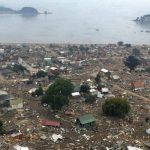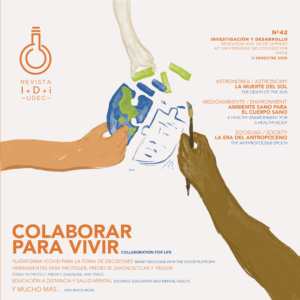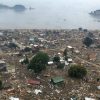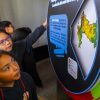By: Gonzalo Medina, Journalist – Interactive Center of Science, Art, and Technology – CICAT UdeC / gomedina@udec.cl
Images: Courtesy of Darío Arellano
Leer en español
Climate change affects biophysical systems and human well-being worldwide. The scientific world, some innovative companies, world leaders, and specific public policies recognize ecological restoration as a mitigation and adaptation strategy to climate change, despite some international political figures denying its effects on immediate life. This is explained by the interactive exhibition Dale Una Vuelta (Give It A Twist), which, as its title suggests, invites us to rethink how we approach the restoration of ecosystem health.
This project was held in 2024 by the University of Concepción’s Interactive Center for Sciences, Arts and Technologies (CICAT), under the leadership of Nataly Viveros, through the National Public Science Competition of the Ministry of Science, Technology, Knowledge and Innovation. The biologist, part of the CICAT educational team, worked in collaboration with Dr. Cristian Echeverría, an academic and scientist at UdeC’s Faculty of Forestry Sciences, to materialize this project, which has had a significant impact on the educational community of the Biobío Region.
Give It A Twist was inaugurated in November 2024 at the Buena Esperanza School in Curanilahue. The exhibition allows participants to embark on a journey from the basic understanding of ecosystems to the complexities of their degradation and restoration efforts through various modules that present the content in a circular way. This involves audiences in an optimistic green journey to discover and interact with ecological restoration.
This exhibition, simultaneously a scientific dissemination strategy, was proposed as an itinerant immersive experience circling through the Curanilahue Cultural Center after being at the school. Since January 2025, it has been presented at CICAT, with an inaugural milestone commemorating the 15 years of operation of the Center in Coronel. It will then visit different spaces and centers in the region.
Chile, the Biobío Region, and climate change
“Ecological restoration is the process of assisting the recovery of a native ecosystem that has been degraded, damaged, or destroyed, leading it to a recovery trajectory where it can adapt and its species can evolve,” explains Nataly Viveros, the Project’s director.
Our country, like other Latin American nations, has faced a loss of extensive areas of native forests, places where ecological restoration plays a leading role in moving towards the recovery of these ecosystems. It is also necessary that the discipline is “professionalized and its practice becomes commonplace and required by the states in the face of any environmental damage,” add Nataly Viveros and Cristian Echeverría, on the role of ecological restoration in public policies and environmental education.
The Biobío Region has been subjected to drastic changes in the landscape, associated with the variation of the uses assigned to the soils, which goes hand in hand with accelerated urban growth. This situation, seen more rapidly in recent years, has led to natural ecosystems facing environmental crises. Within the exhibition, different videos and a projection in the same circular module give an account of humans’ influence on climate change, inviting participants to reflect and take a position.
Factors such as population growth, real estate, excessive product consumption, and the increasing frequency of phenomena associated with climate change, such as wildfires, have impacted the health of natural ecosystems. But all is not lost, and an example found in Give It A Twist is the possibility of hearing the song of different birds that return to their natural habitat after a mega-fire or of recognizing through smell various native trees that are reborn, such as bay laurel, Chilean acorn, and boldo.
Give It A Twist helps to inform and educate the population about the actions they can take to face climate change, or to marvel at the ecological restoration carried out by the ecosystems themselves, which allow new trees and birds to grow and sing in what we call ‘forest’.
VISIT THIS AND OTHER CICAT EXHIBITIONS
Last modified: 3 de septiembre de 2025






